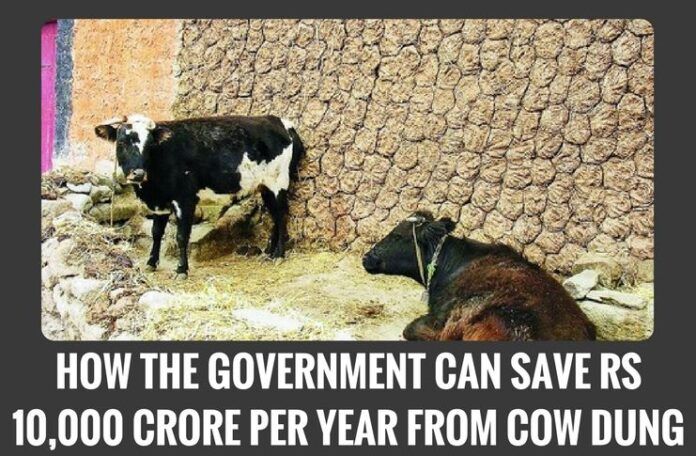
Biogas: Government can save $1.5 Billion from cow dung
[dropcap color=”#008040″ boxed=”yes” boxed_radius=”8px” class=”” id=””]T[/dropcap]his article comes at a time when there’s a hot debate about cow slaughter and cattle sale for slaughter. This suggestion for the Government is not a typical macroeconomic topic we usually discuss in these columns. It may interest only a few readers, but it can save over Rs 10,000 Crores [$ 1503.138 Million] per year for the Government and the people, and offer many other benefits.
Under the Pradhan Mantri Ujjwala Yojana (PMUY), Rs.8,000 crore [$ 1202.51 Million] has been earmarked for providing 5 crore [$ 775,950.92] LPG connections to poor households. Each beneficiary will get financial support of Rs.1,600 [$ 24.83] for securing an LPG connection. The poor still have to pay out Rs 430 [$ 6.67] per cylinder when they buy the LPG cylinders.
From the Government’s side, each beneficiary will be additionally given LPG subsidy of about Rs 250 [$ 3.88] per cylinder (assuming LPG cylinder prices don’t increase from the current levels). At an average consumption of just 6 cylinders a year per family (a little less than the national average of 6.28), this works out to a subsidy of about Rs 1500 [$ 23.28] a year. For 5 years, this subsidy works out to about Rs 7500 [$ 116.40] per family. Combined with the initial financial support of Rs 1,600 [$ 24.83] per connection, the total subsidy works out to about Rs 9,000 [$ 139.68] per beneficiary family for about 5 crore families over a 5-year cycle.
There’s a way the Government can slightly alter the PMUY program and make it even more successful for the Government, and yet more attractive to the beneficiaries too, and save Rs 10,000 crores [$ 1503.138 Million] per year for the Government and the beneficiaries.
[dropcap color=”#008040″ boxed=”yes” boxed_radius=”8px” class=”” id=””]B[/dropcap]iogas systems have long been a cost-effective alternative to meet the cooking fuel needs of rural poor, not only in India but across Asia. “Brick and mortar” and plastic makes of biogas systems have been the most common. They have been difficult to build/ buy, transport, install and maintain, and have been often costly. When such systems become dysfunctional, the rural poor have no easy way of repairing and getting them back in operation. Hence, there are lots of abandoned biogas systems across India.
“The Government can bear 60% of this EMI (Rs 115 i.e. $ 1.78 per family) and the balance amount of about Rs 75 [$ 1.16] per month per family can be borne by the beneficiaries.
Many State Governments have offered subsidies to make them affordable, but this has not increased the number of biogas installations substantially, which is why the Government had to come up with the PMUY program. If biogas systems were successful, the rural poor would not have needed any help under PMUY. Also, to avail subsidy, only certain makes and models have been permitted, unintentionally scuttling competition and creative solutions that could overcome the problems with typical biogas systems.
Typical biogas systems (1 m3/day biogas capacity) for such volumes, including installation, commissioning and AMC costs, can be sourced at Rs 9,000 each [$ 139.68] (with a built-in 5-year warranty and maintenance). On EMI basis, it should be possible to procure them at Rs 190 [$2.95] per month for 5 years. These systems have a typical lifespan of 6 years. The Government can bear 60% of this EMI (Rs 115 i.e. $ 1.78 per family) and the balance amount of about Rs 75 [$ 1.16] per month per family can be borne by the beneficiaries. This will save about Rs 2,000 [$ 31.04] for the Government (including saving the initial financial support for the LPG) and Rs 1,680 [$ 26.07] per year for the beneficiaries.
So, assuming 3 crore rural families as the beneficiaries of this Project, it can save, for the Government and the people together, over Rs 10,000 crores [$1503.138 Million ] (= 3 crore X (2000+1,680)) per year, apart from the other benefits outlined herein.
With this suggestion, one of the important limitations with the current PMUY Scheme will be overcome. A 1 m3/day biogas system will give 12 LPG cylinders equivalent biogas per year, not just 6 as in the case of LPG. So, the beneficiary family can do a lot more of cooking/ heating with the biogas system than it can with the LPG system.
[dropcap color=”#008040″ boxed=”yes” boxed_radius=”8px” class=”” id=””]T[/dropcap]he Government optionally can alter its own relative contributions to EMI vis a vis of the beneficiaries.
The additional benefits of the biogas system are:
(i) Biogas is safer to operate than LPG, as biogas is not under pressure.
(ii) Biogas system will reduce GHGs (greenhouse gases) substantially, giving our Government additional bargaining power in climate change talks.
(iii) Reject from biogas system is pathogen-free organic manure rich in NPK, better than raw cow dung (which has pathogens), and even better than chemical fertilizers. The slurry can be used as manure directly or after composting/ vermicomposting.
(iv) It will lead to cleaner villages, contributing to Swachh Bharat scheme.
(v) It will generate a few thousand rural manufacturing jobs to make these biogas systems and a few thousand rural jobs for artisans to maintain these systems.
(vi) It will save valuable Foreign Exchange, spent otherwise in the case of LPG gas.
Note:
1. Text in Blue points to additional data on the topic.
2. The conversion rate used in this article is 1 US Dollar = 64.43 Rupees
3. Text in Bold points to additional data on the topic.
- How BJP can get 33%+ vote share in TN - April 1, 2024
- A transparent, equitable electoral funding alternative - March 19, 2024
- How TN BJP can come to No. 1 or No. 2 in 2024 LS polls - January 11, 2024









Tou are all right sir !!!
Excellent article but the real value of our animals has been grossly understated.
–
If only India imposes a stringent ban on CHEMICAL FARMING & closes all the SLAUGHTER HOUSES, India can judiciously employ her animals to:
1. Supply METHANE COOKING GAS to all Indian families almost free of cost
2. Generate domestic Electricity for the entire nation @ 1 rupee/unit
3. Transport all Indians @ 1 Rupee /5 KM
4. Above all supply very ‘rich & toxin free’ manure & pest repellent to all our farms @ 25% of the cost of harmful chemical fertilizers.
–
All that the Government requires to do is to resist the frustrating efforts by the nefarious ‘meat mafia’ & the vicious ‘Chemical fertilizer mafia’
–
Except Sikkim, no other Governments (the center/state) seems to have realized the potential of our cattle or have caved in to the pressure by the mafia groups.
Though I’m a biogas enthusiast, I don’t believe biogas economics is that simple. I’m only arguing that, if you have a couple of cows anyway, with a modest investment, biogas makes sense in rural areas. When the cows go past their milching period, the economics is not as attractive, because tending to the cows requires significant money and time.
The commercial value of Cowdung and urine are grossly overstated in the SC petition and many WhatsApp messages doing the rounds. If true, biogas will be the next biggest business opportunity, bigger than Apple and Google combined. Obviously it’s not true.
I’ve grown with cows and bulls in my childhood. They were our family members. I loved them. I hate to see them butchered, today. I’m a pure vegetarian. So, slaughtering any animal is no-no to me.
But my views can’t dictate what the rest of the country should do or not do. A poor farmer’s business model includes selling cows beyond milching age and buying milch cows, barring a few who take care of them even in their old age. Already most farmers are living hand to mouth, at best.
Even a Govt can’t dictate when it comes to people’s livelihood. I feel very sad to say this, but if people sell their cows for slaughtering, I see no way I can prevent it. Even majority opinion can’t decide on behalf of the poor farmer.
Government should provide technical support for one model biogas unit in each village in India which has good population of cattle
Others in the village will automatically follow
My father built one in 1980. Fixed dome type unfortunately there were too much leak of gas at the top. Took a while to figure out and fix it. Most villagers where following that case. Had it succeed timely most in my village would have adopted it
Now no one in my village has cattle. They use tractor for ploughing, buy milk from outside